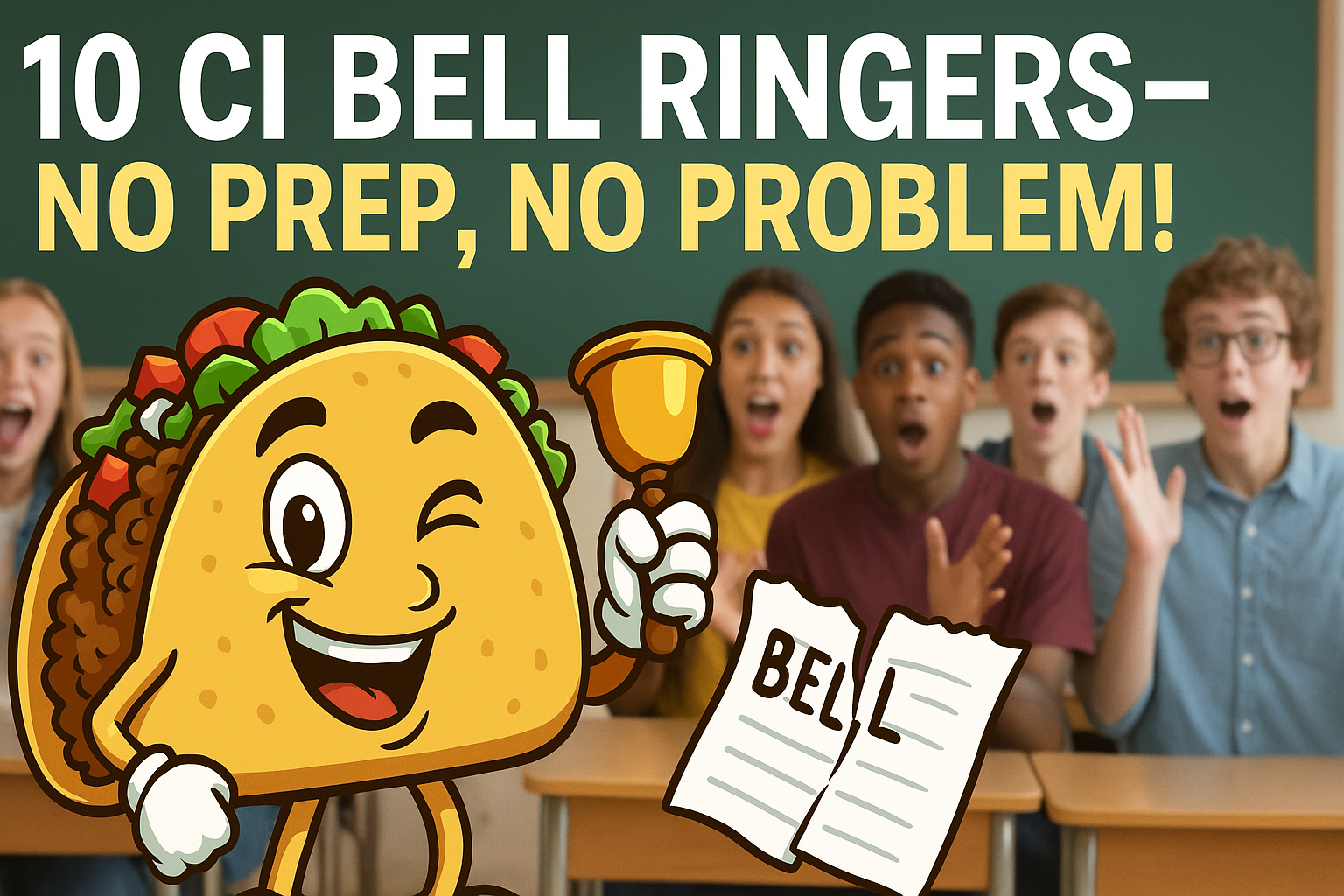
10 Ideas Teachers Can Rotate Daily with Zero Prep (and Zero Tears)
Welcome to the CI Bell Ringer Support Group
Let’s be honest: the first 5 minutes of class are a mess.
Students walk in like baby giraffes learning to walk… while texting… and arguing about who “definitely owes them a pencil.” You, meanwhile, are trying to take attendance, deflect chaos, and mentally calculate whether you drank actual coffee or just imagined it.
Enter the humble bell ringer.
But not just any bell ringer. I’m talking CI-friendly, zero-prep, magical unicorn bell ringers that get your students engaged in target language input faster than you can say “¡Empezamos!”
The good news? You don’t need 87 slides or a Netflix documentary budget. You need 10 go-to activities that rotate like your favorite pair of teacher shoes: dependable, comfy, and still impressively effective.
This article will walk you through the five core principles of effective CI bell ringers—each packed with hilarious, helpful, and practical strategies that work in real classrooms full of real chaos. (Spoiler alert: It ends with a taco.)
Principle 1: Bell Ringers Shouldn’t Feel Like a Second Job
If your bell ringer requires more setup than the Super Bowl Halftime Show… it’s not a bell ringer—it’s a full-time gig. And you’re already booked.
CI-friendly bell ringers should feel like teacher autopilot. You know it’s good when you’re munching pretzels and students are silently working… in the target language… without you lifting a dry erase marker.
Try these:
- “Meme of the Day”: Post a funny or absurd meme in the TL. Ask students to translate, rate it, or guess the context. Bonus: You’ll seem wildly relevant.
- “2 Truths and a Lie: Teacher Edition”: Drop three facts about yourself in the TL. Let them vote. The more unhinged, the better.
- “Screenshot Scene”: Take a paused moment from a funny video or story and ask: “¿Qué pasó antes?” (What happened before?) Their guesses often involve aliens, llamas, or your lunch.
No prep. No stress. All input.
Principle 2: Start with Input, Not Interrogation
Picture it: A kid sits down, bleary-eyed, hoodie up, brain still buffering. And then you hit them with “¿Qué hiciste el fin de semana?”
Cue: panic, shame, or that weird noise only teenagers can make that might be “uhh” or “I’m dying.”
Instead, give them something rich, clear, and contextual to read, watch, or interpret. THEN engage.
Try:
- “Story Strip Starter”: Write the first line of a weird mini story. Let them illustrate the rest or write one more line. Today’s plot twist? A squirrel stole the school bus.
- “Mini MovieTalk”: A 10-second clip from a Pixar short or cat video. Ask: “¿Qué está haciendo el gato?”
- “Profe’s Weird Day”: Start with “Hoy, Profe comió cereal con agua.” Let students process, translate, and judge your life choices.
Students get input. You get peace. Win-win.
Principle 3: Rotate Like a Pro
The trick to staying sane? Build a short rotation. Ten ideas is the sweet spot: enough variety to stay fresh, but not so many that your brain falls out.
Here’s a quick peek into a rotation that actually works:
- Monday: “Emoji Recap” – Tell yesterday’s story using only emojis. Students translate.
- Tuesday: “Persona Interview” – One student, five pre-written questions in TL.
- Wednesday: “Which One Is Fake?” – Three sentences. One is nonsense. Students vote.
- Thursday: “One Word, Five Ways” – One vocab word, five simple sentences.
- Friday: “Silent Drama” – Project a silent GIF. Ask: “¿Qué pasa?”
Boom. Five minutes, five days, full of input.
Principle 4: Trick Students into Learning (They’ll Thank You Later. Maybe.)
Let’s be real—students don’t love “learning” as much as they love decoding chaos, laughing at llamas, or guessing whether you secretly went skydiving.
CI bell ringers don’t need to scream “I’m a vocabulary review!” They just need to whisper, “I’m fun, and oh by the way…you’re acquiring language.”
Try these Jedi mind tricks:
- “Emoji Gossip”: Use 4 emojis to describe something about yourself. Students decode it. Then, they create one about a classmate. You’ve now taught reflexive verbs without pain.
- “Drama Llama Diaries”: Create a recurring character who’s always in a weird situation: “El Drama Llama está en el supermercado…sin pantalones.” Discuss.
- “Teacher Diary Entry”: You write one sentence. “Hoy, no tengo voz porque grité en el tráfico.” Students react, rewrite, or continue it.
They think it’s a game. You know it’s input. Muahahaha.
Principle 5: Targeted Input Doesn’t Mean Dry and Boring
Just because you want to hit a structure doesn’t mean you need to be the input police. You can sneak it in like veggies in mac & cheese.
Choose one structure per week. Then, repeat it like it owes you money—but in fun, story-based ways.
Let’s say your structure is “le gusta.”
- Monday’s bell ringer: “¿A quién le gusta comer pizza con cereal?” (yes/no poll)
- Tuesday: “Drama Llama le gusta gritar en la biblioteca.” (reaction + rewrite)
- Wednesday: “¿Qué le gusta a tu gato imaginario?” (absurd brainstorm)
One structure, 5 formats. Students don’t even notice they’re mastering it. That’s the dream.
Conclusion: Bell Ringers That Actually Ring in Language Growth
You don’t need to reinvent the wheel—or laminate 47 task cards—to start class with strong CI. A good bell ringer:
- Gets students focused
- Starts input from second one
- Targets language naturally
- Feels fun
- Takes zero brain power at 7:59 a.m.
So, go forth and start class like the confident, coffee-wielding CI wizard you are.
And if you want even more help managing the chaos (without selling your soul to the classroom behavior gods), check out the Dynamic Discipline Course. You’ll learn how to build routines that stick, relationships that matter, and classroom management that doesn’t eat your lunch.
Oh, and want to know how your CI practice stacks up? Take the CI Proficiency Quiz and get some honest, helpful feedback—and maybe a virtual high five. 🙌
Key Takeaways
- CI bell ringers should be fast, funny, and full of input—not extra work for you.
- Start with input-rich activities like stories, memes, or short clips to ease students in.
- Rotate 10 easy formats across your week to keep things fresh and manageable.
- Sneak in your target structures with humor and creativity for natural acquisition.
- Use characters, chaos, and a little bit of teacher oversharing to maximize engagement.



